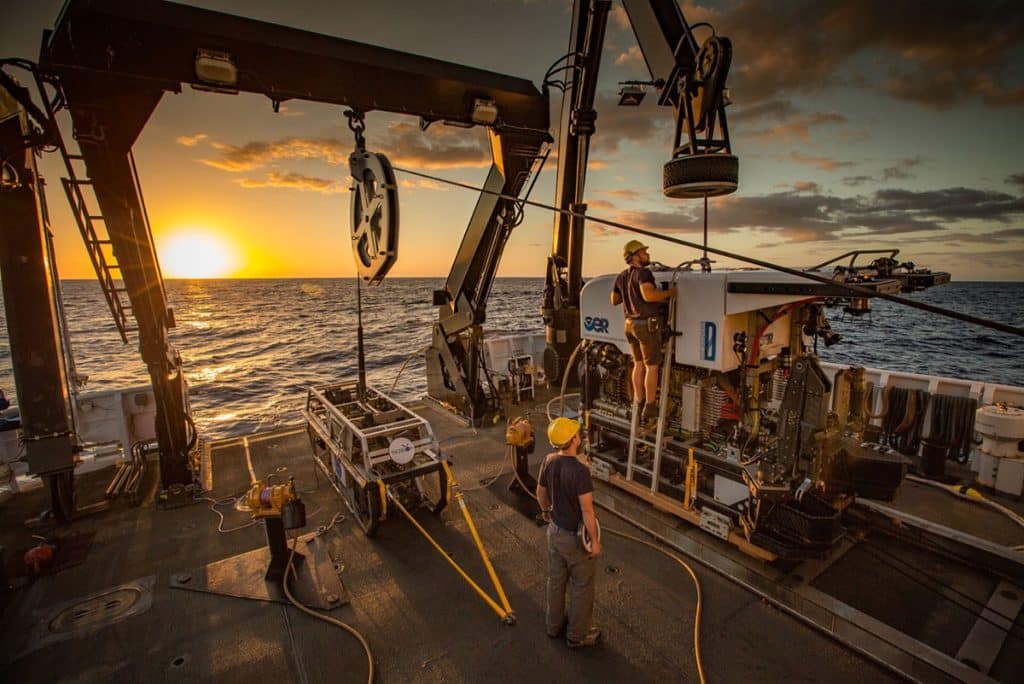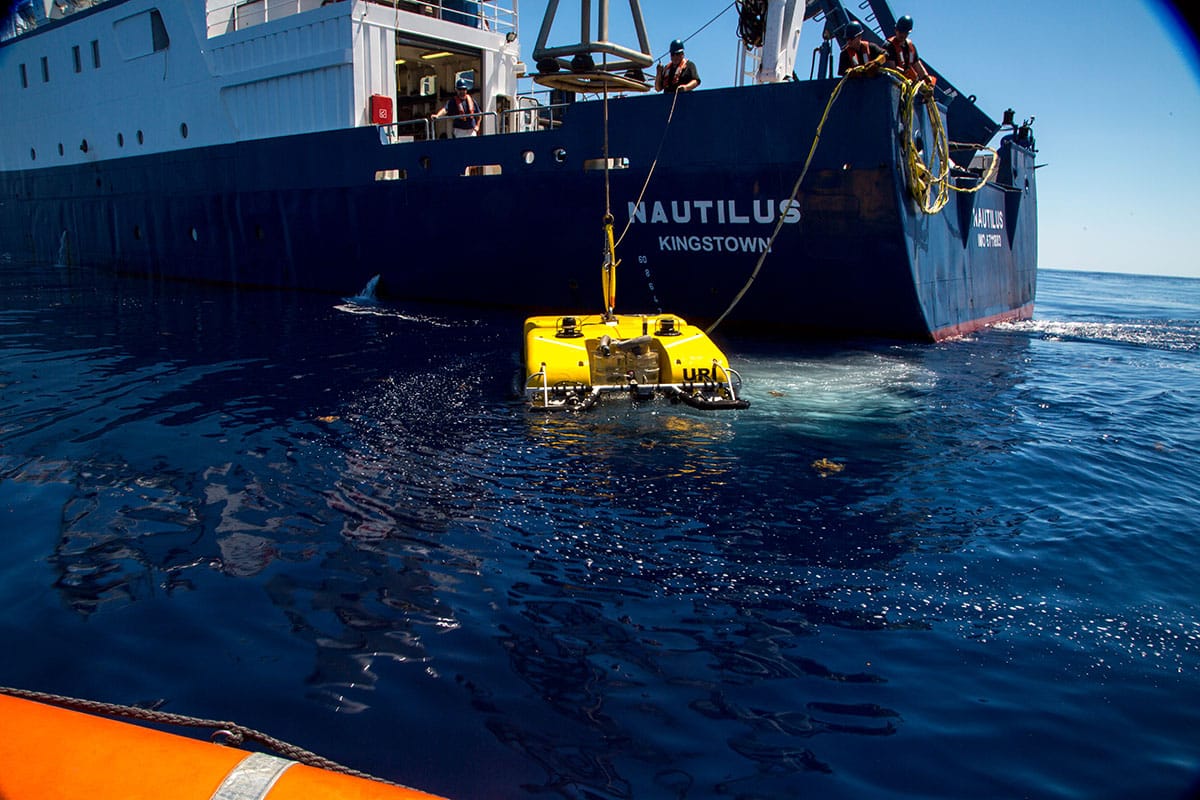From Unmanned Systems Magazine: How autonomous and remote underwater vehicles are boosting global maritime operations
March 9, 2020 | AUVSI News

Editor’s note: To hear more on this topic and to visit with exhibitors at a Maritime Pavilion, register for Xponential 2020 here.
In January 1942, a 6,768-ton, 422.8-foot long British tanker, just five years old, steamed off Long Island, reporting that a menacing U-boat in its area was “increasingly serious.”
On Jan. 15 of that year, the tanker, the Coimbra, was sunk by a German U-boat, taking it down and killing most of the crew. At the time, it had 2.7 million gallons of lubricating oil onboard. For 77 years, the oil would seep out, little by little — until recently.
The U.S. Coast Guard, in partnership with the New York State Department of Environmental Conservation commissioned an ROV, or remotely operated vehicle, to find the oil and the leak and fix it.
The Coimbra is one of 87 wrecks beneath the ocean’s surface that pose environmental risk. It is one example of how autonomous underwater vehicles (AUVs) and ROVs are being used to solve a myriad of problems. From environmental remediation of hazardous materials in shipwrecks, to hydrographic research and exploration, and discovery of long-lost sunk ships of bygone eras —including the Titanic — AUVs and ROVs are coming of age as useful equipment to explore and improve the world’s ocean depths.
Growing market
The global offshore AUV and ROV Market was valued at $3.5 billion and is projected to grow at about 18% per year over the next six years. The worldwide market for AUVs and ROVs is ripening as they are able to enter risky and hard-to-access areas where humans can’t go, or would be endangered if they did.
AUVs are used for underwater survey tasks: the discovery and mapping of submerged wrecks, as well as obstructions that might obstruct navigation for commercial and recreational vessels.
An AUV operates autonomously, without operator intervention. When it finishes its mission, it returns to a preprogrammed location. Its data and information is then gathered and dowloaded for further analysis.
An ROV differs from an AUV in that it is tethered to a ship or offshore platform by cable. The cables enable maneuverability of the ROV, allowing it to travel and perform per the control of a remote operator. It may include cameras, lights, sonar, and articulating arms. It may be coordinated to retrieve objects, cut lines, or assist in lifting objects. While a human diver could perform the same functions, an ROV may not only assist a diver, but also go where it would be unsafe for a diver to go.
 The ROV Hercules deploys from the Exploration Vessel Nautilus. Photo: Ocean Exploration Trust
The ROV Hercules deploys from the Exploration Vessel Nautilus. Photo: Ocean Exploration Trust
Discovering the Titanic
In August 1985, 73 years after its sinking, explorer and conservationist Robert Ballard led an American-French expedition from the U.S. Naval vessel Knorr to the sunken ship’s location, 380 miles southeast of Newfoundland. The Knorr deployed the Argo, a 16-foot submersible sled outfitted with a remote-controlled camera that transmitted live images to a monitor.
Down it went, 13,000 feet beneath the Atlantic Ocean, and transmitted video back to the Knorr. The massive steam boilers of the Titanic were the first structures discovered. It showed the Titanic to be in two pieces, with an intact bow, but a damaged stern.
The survey shed light on to the maritime disaster. Originally, it was thought that the Titanic struck an iceberg, gashing its hull and causing it to flood. After the surveillance and exploration using the ROV, the sinking was thought to be caused by a series of fatigue cracks at stressful tank seams, causing flooding in various places.
In August 2019, National Geographic reported that “based on years of careful analysis of the wreck, which employed then state-of-the-art flooding models and simulations used in the modern shipping industry, experts are able to paint a gruesome portrait of Titanic’s last hours and minutes.”
Using the images captured by the ROV, and later creating 3-D models, they explained the ship did not merely slip beneath the ocean waves, but, as a result of the initial blow, “the bow had filled with water and the stern had risen high enough into the air to expose the propellers and create catastrophic stresses on the middle of the ship. Then the Titanic cracked in half.”
Force multiplier
AUVs — sometimes also referred to as unmanned underwater or undersea vehicles, or UUVs — play a key role in mine countermeasures in conventional warfare. William F. Hanlon IV is the chief engineer of the USNS Hershel “Woody” Williams, Expeditionary Sea Base (ESB) 4, an expeditionary mobile base Navy vessel operated by the Military Sealift Command and homeported in Norfolk, Virginia.
“One of the primary missions of the Expeditionary Sea Base class of vessels is mine countermeasures,“ says Hanlon. “Designed primarily around the use of an MH-53E [Sea Dragon helicopter] towing a MK 105 Magnetic Mine Sweeping Sled, the vessel had to adapt to technological advances which have made UUVs and ROVs more portable and capable of being deployed on various vessels.
“These technological advances of unmanned undersea vehicles and remotely operated vehicles have increased their utility and capability within the military community,” he says. “The ability for the ESB Class to utilize the same vehicles as the LCS Class demonstrates the modularity that is being designed into these systems. This capability is a force multiplier when considering the contested environments that ships operate in today.”
Hanlon says he believes the use of ROVs and AUVs will become more prevalent within the oceangoing community as the technology continues to advance.
“The United States Navy has already designed this modularity and capability into their ships and continues to look for areas to retrofit this capability in other classes,” he says. “Soon, the commercial world will follow with initial retrofits, which will eventually lead to designing certain merchant ships around the capability of utilizing UUVs and ROVs possibly changing the way we design ships.”
From Hanlon’s perspective, standardization of UUVs is needed. If manufacturers could develop a standardized plug system so as to easily integrate into ships, it would greatly boost the capability of UUV and ROV capability.
“Currently, ships have to have designated spots to land TEUs [20-foot equivalent units, a measure of cargo capacity] for power, support, operation, and communications for each type of UUV/ROV,” he says. “When loading 12-plus TEUs for a multi-capable mission package, this ability to land all TEUs for a certain piece of equipment near each other makes planning, installing, launching, and recovery less time consuming.”
He continues, “The potential of these vehicles is incredible. The technology seems to be growing exponentially, utilizing greater robotic abilities and possible inclusion of artificial intelligence these vehicles create the ability to open up and get a better understanding of what’s below the surface of our oceans. Ultimately, no matter how advanced we think our current vehicles are, they will only become smaller, more efficient, and more autonomous, creating the ability to launch teams of vehicles to perform mapping functions, exploration or even salvage.”
Underwater flexibility
William Courtney is a Chief Mate, also with the U.S. Navy’s Military Sealift Command and has worked with in maritime environments where ROVs and AUVs are used. He views ROVs and AUVs as allowing greater flexibility for subsea missions.
“On the surface and underwater, unmanned vehicles can generally tolerate more adverse environmental conditions such as sea state, current, temperature, than divers can, which minimizes downtime due to poor conditions,” he says.
Courtney says this equipment doesn’t require a lot of downtime aside from maintenance and recharging. With multiple vehicles, simultaneous missions are possible, as well as more and longer continuous missions.
The use of ROVs and AUVs, Courtney says, may coordinate with vessel equipped with dynamic positioning — which allows them to keep station over a specific point — for even greater flexibility to investigate targets of opportunity or reposition a ship or floating platform as needed without anchoring or mooring systems normally required for diving operations.
“I anticipate that unmanned systems will continue to grow in reliability, endurance, range, battery power, and overall capability,” Courtney says. “The systems that handle them will likely continue to become smaller, more streamlined and portable.”
Like Hanlon, Courtney believes artificial intelligence may boost underwater vehicle effectiveness in the future.
Courtney says experience from U.S. Navy Mobile Diving and Salvage Units and mine-hunting teams using small and portable vehicles will lead to more of them being used, which in turn will make them cheaper and more attractive to smaller operations with limited capital who wish to enhance their subsea capability.
The subsea capabilities of AUVs and ROVs are many. From salvage operations to defense, offshore explorations and other maritime operations, underwater vehicles are game changers. They’ll likely continue to improve any subsea operations and may even play an important role in an emergent “blue economy” poised to capitalize on the resources beneath the ocean, safely and responsibly.
As for the Coimbra, the ROV was able to find the precise location of the leak: a pinhole opening in a tank, with other nearby tanks containing oil also. Recovery and cleanup is underway, 77 years late, thanks to an ROV that could submerge and survey the wreck without risking human life.
Above: The science team of the EV Nautilus on deck. Photo: Ocean Exploration Trust. Below: The Deep Discoverer ROV on the deck of the Okeanos Explorer, a ship operated by the National Oceanic and Atmospheric Administration. Photo: NOAA


